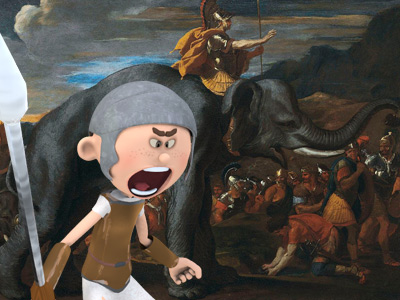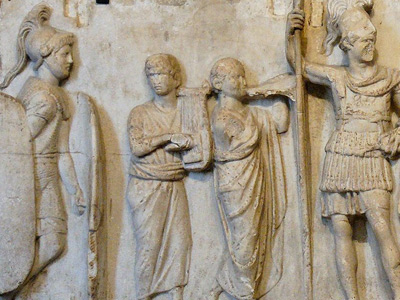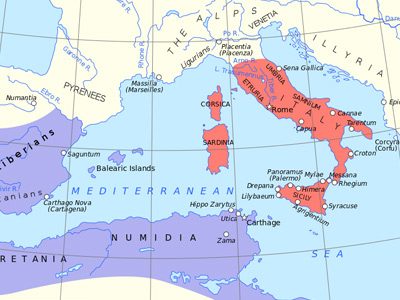First Punic War (264-241 BC)
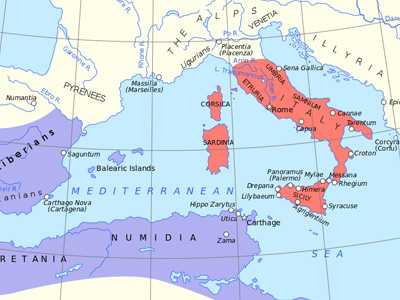
The First Punic War (264 to 241 BC) was the first of three wars fought between Ancient Carthage and the Roman Republic. For more than 20 years, the two powers struggled for supremacy, primarily on the Mediterranean island of Sicily and its surrounding waters, and also in North Africa. The war signaled the beginning of a strategic transformation in the western Mediterranean. Carthage began the war as the great sea-power of the western Mediterranean, while Rome had but a small fleet of fighting ships. Over the course of the war, Rome built up a powerful navy, developed new naval tactics, and strategically used their navy, army, and local political alliances on Sicily in order to achieve a victory that expelled the Carthaginians from Sicily. The First Punic War ended with a treaty between Rome and Carthage, but years of bloodshed were to follow in the Second and Third Punic Wars before the strategic issue of power in the western Mediterranean was resolved in favor of Rome, and in the total destruction of Carthage.
The series of wars between Rome and Carthage took the name "Punic" from the Latin name for the Carthaginians, Punici. This is derived from Phoenicis (Phoenicians), and it refers to the Carthaginian heritage as Phoenician colonists. A Carthaginian name(s) for the conflicts does not survive in any records.
Role of Naval Warfare
Due to the difficulty of operating in Sicily, most of the First Punic War was fought at sea, including the most decisive battles. But one reason the war bogged down into stalemate on the landward side was because ancient navies were ineffective at maintaining seaward blockades of enemy ports. Consequently, Carthage was able to reinforce and re-supply its besieged strongholds, especially Lilybaeum, on the western end of Sicily. Both sides of the conflict had publicly funded fleets. This fact compromised Carthage and Rome's finances and eventually decided the course of the war.
Despite the Roman victories at sea, the Roman Republic The Roman Republic was a form of government of Rome and the era of the classical Roman civilization when it was run through public representation of the Roman people. Beginning with the overthrow of the Roman Kingdom (traditionally dated to 509 BC) and ending in 27 BC with the establishment of the Roman Empire, Rome's control rapidly expanded during this period - from the city's immediate surroundings to hegemony over the entire Mediterranean world. lost countless ships and crews during the war, due to both storms and battles. On at least two occasions (255 and 253 BC) whole fleets were destroyed in bad weather; the disaster off Camarina in 255 BC counted two hundred seventy ships and over one hundred thousand men lost, the greatest single loss in history. One theory is that the weight of the corvus on the prows of the ships made the ships unstable and caused them to sink in bad weather. Later, as Roman experience in naval warfare grew, the corvus device was made attachable and detachable due to its impact on the navigability of the war vessels.
The Roman Republic was a form of government of Rome and the era of the classical Roman civilization when it was run through public representation of the Roman people. Beginning with the overthrow of the Roman Kingdom (traditionally dated to 509 BC) and ending in 27 BC with the establishment of the Roman Empire, Rome's control rapidly expanded during this period - from the city's immediate surroundings to hegemony over the entire Mediterranean world. lost countless ships and crews during the war, due to both storms and battles. On at least two occasions (255 and 253 BC) whole fleets were destroyed in bad weather; the disaster off Camarina in 255 BC counted two hundred seventy ships and over one hundred thousand men lost, the greatest single loss in history. One theory is that the weight of the corvus on the prows of the ships made the ships unstable and caused them to sink in bad weather. Later, as Roman experience in naval warfare grew, the corvus device was made attachable and detachable due to its impact on the navigability of the war vessels.
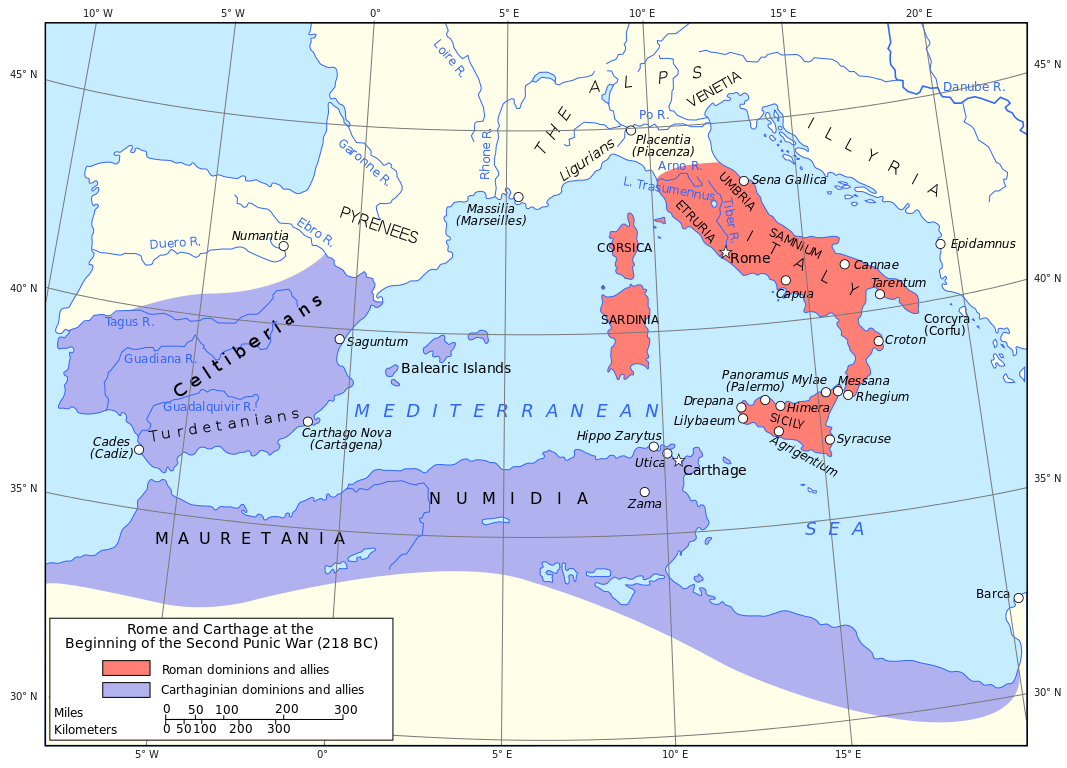
Map showing Rome and Carthage at the start of the Second Punic War and the theatre of the Punic Wars

Map showing Rome and Carthage at the start of the Second Punic War and the theatre of the Punic Wars
( Click image to enlarge)
Aftermath
Rome won the First Punic War after 23 years of conflict and in the end became the dominant naval power of the Mediterranean. In the aftermath of the war, both states were financially and demographically exhausted. Corsica, Sardinia and Africa remained Carthaginian, but they had to pay a high war indemnity. Rome's victory was greatly influenced by its persistence. Moreover, the Roman Republic's ability to attract private investments in the war effort to fund ships and crews was one of the deciding factors of the war, particularly when contrasted with the Carthaginian nobility's apparent unwillingness to risk their fortunes for the common war effort.
Casualties
The exact number of casualties on each side is difficult to determine, due to bias in the historical sources.
According to sources (excluding land warfare casualties):
- Rome lost 700 ships (in part to bad weather) with an unknown number of crew deaths.
- Carthage lost 500 ships with an unknown number of crew deaths.
Although uncertain, the casualties were heavy for both sides. Polybius commented that the war was, at the time, the most destructive in terms of casualties in the history of warfare, including the battles of Alexander the Great. Analyzing the data from the Roman census of the 3rd century BC, Adrian Goldsworthy noted that during the conflict Rome lost about 50,000 men. This excludes auxiliary troops and every other man in the army without citizen status, who would be outside the head count.
Peace Terms
The terms of the Treaty of Lutatius designed by the Romans were particularly heavy for Carthage, which had lost bargaining power following its defeat at the Aegates islands. Accordingly, Carthage agreed to:
- evacuate Sicily and the small islands west of it (Aegadian Islands).
- return its prisoners of war without ransom, while paying a heavy ransom of their own.
- refrain from attacking Syracuse and her allies.
- transfer a group of small islands north of Sicily (the Aeolian Islands and Ustica) to Rome.
- evacuate all of the small islands between Sicily and Africa (Pantelleria, Linosa, Lampedusa, Lampione and Malta).
- pay a 2,200 talent (66 tonnes/145,000 pounds) of silver indemnity in ten annual installments, plus an additional indemnity of 1,000 talents (30 tonnes/66,000 pounds) immediately.
Further clauses determined that the allies of each side would not be attacked by the other, no attacks were to be made by either side upon the other's allies and both sides were prohibited from recruiting soldiers within the territory of the other. This denied the Carthaginians access to any mercenary manpower from Italy and most of Sicily, although this later clause was temporarily abolished during the Mercenary War.
Political Results
In the aftermath of the war, Carthage had insufficient state funds. Hanno the Great tried to induce the disbanded armies to accept diminished payment, but kindled a movement that led to an internal conflict, the Mercenary War. After a hard struggle from the combined efforts of Hamilcar Barca, Hanno the Great and others, the Punic forces were finally able to annihilate the mercenaries and the insurgents. However, during this conflict, Rome took advantage of the opportunity to strip Carthage of Corsica and Sardinia as well.
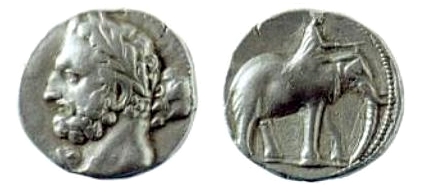
Perhaps the most immediate political result of the First Punic War was the downfall of Carthage's naval power. Conditions signed in the peace treaty were intended to compromise Carthage's economic situation and prevent the city's recovery. The indemnity demanded by the Romans strained the city's finances and forced Carthage to look to other areas of influence for the money to pay Rome.
Carthage, seeking to make up for the recent territorial losses and a plentiful source of silver to pay the large indemnity owed to Rome, turned its attention to Iberia; and in 237 BC, the Carthaginians, led by Hamilcar Barca, began a series of campaigns to expand their control over the peninsula. Though Hamilcar was killed in 229 BC, the offensive continued with the Carthaginians extending their power towards the Ebro valley and founding "New Carthage" in 228 BC. When Carthage besieged the Roman protected town of Saguntum in 218 BC, it ignited the Second Punic War with Rome.
As for Rome, the end of the First Punic War marked the start of Rome's expansion beyond the Italian Peninsula. Sicily became the first Roman province (Sicilia) governed by a former praetor, instead of an ally. Sicily would become very important to Rome as a source of grain. Importantly, Syracuse was granted nominal independent ally status for the lifetime of Hiero II, and was not incorporated into the Roman province of Sicily until after it was sacked by Marcus Claudius Marcellus during the Second Punic War.
HISTORY
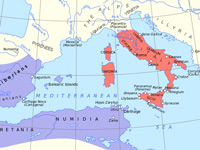
RESOURCES
This article uses material from the Wikipedia article "First Punic War", which is released under the Creative Commons Attribution-Share-Alike License 3.0.
© Stories Preschool. All Rights Reserved.
